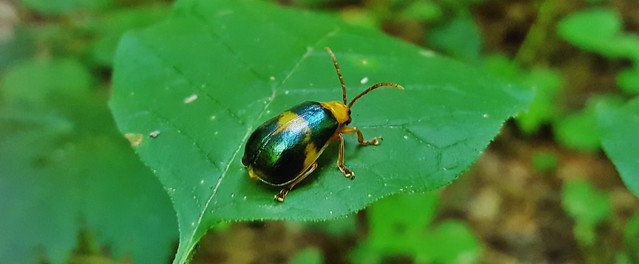This is the fourth part of a series on winter tree insects. This article examines elm leaf beetle and elongate hemlock scale.
Introduction
Through the winter months, plants conserve their energy, often enduring inclement weather in anticipation of spring. Due to the frigid temperatures, many insects enter a state of dormancy, overwintering on or within their hosts. While some insects are visible during winter, others conceal themselves in bark crevices or beneath the soil surface. The following examines some of the most common insects to infest trees during winter, and how they may be observed.
Elm Leaf Beetle (Xanthogaleruca luteola)
Elm leaf beetle is a significant nuisance of elm trees. The adults and larvae feed on the foliage of elms. When populations are dense, elms may be completely defoliated. Repeated defoliation reduces tree vigor, and may result in tree mortality.
Hosts
Elm leaf beetle infests American elm, Chinese elm, English elm, Scots elm, Siberian elm, and Zelkova, as well as numerous cultivars. Landscape trees are typically more susceptible to infestation than those in forested settings.
Symptoms of Infestation
The adults chew through leaves, creating small holes in the leaf surface. The larvae skeletonize the leaf surface. Damaged foliage will generally turn brown to white. Dense adult populations can partially or completely defoliate a large elm tree. This disrupts the photosynthetic process, impeding the tree’s ability to grow. Severely weakened trees are often bereft of growth. Trees that are defoliated will usually produce a second flush of growth, which may be readily consumed by subsequent generations of elm leaf beetle.
Management
- Maintain tree vigor through sound cultural practices. Ensure that elms are sufficiently watered, especially during periods of extended drought.
- Apply a layer of organic mulch around the base of trees. Proper mulching will improve the soil quality, conserve soil moisture, and moderate the soil temperature.
- Promptly remove any dead or diseased branches. Prune trees periodically to improve air circulation through the crown, and facilitate a rapid drying of the foliage.
- When planting, select cultivars that exhibit an increased resistance to elm leaf beetle.
- Elm leaf beetle has several natural predators, including certain flies, wasps, earwigs, lacewing larvae, and a predaceous ground beetle. The small black tachinid fly parasitizes the larvae. It lays its eggs in the larvae. Once the eggs have hatched, the larvae are devoured from within. The tiny wasp, Oomyzus gallerucae, feeds on the eggs.
- Tree trunks can be banded with insecticides. Banding elm trees can limit beetle populations by killing the larvae as they navigate down the main trunk prior to pupation.
- Buildings located close to infested trees should be sealed to prevent the beetles from overwintering in them.
- Systemic insecticides can be injected into the soil. Perform initial applications in spring, as leaf expansion begins.
Elongate Hemlock Scale (Fiorinia externa)
Fiorinia externa, also referred to as elongate hemlock scale or fiorina scale, is an insect native to Japan that infests eastern hemlock, northern Japanese hemlock, Carolina hemlock, fir, and spruce. Elongate hemlock scale may also be observed on cedar, Douglas-fir, pine, and yew, which tend to grow adjacent to infested hemlocks. Elongate hemlock scale has become a problem in North America, where it sometimes occurs with two other exotic pests: the circular hemlock scale Nuculapsis tsugae, and the hemlock wooly adelgid Adelges tsugae. Mixed infestations of scale insects and adelgids can cause hemlocks and other affected plants to decline rapidly.
Hosts
Elongate hemlock scale develops and reproduces on forty three plant species, representing seven genera of native and exotic conifers, including fourteen species that are native to the United States. Though hemlocks are common hosts, spruce and fir tend to be more susceptible to infestation.
Symptoms of Infestation
Elongate hemlock scale populations typically build slowly on healthy trees. They accumulate more rapidly on stressed, or wounded trees. As the scale feed, they cause foliage to turn yellow, and drop prematurely. Dieback of major limbs may occur, progressing upwards through the tree. Dieback generally occurs when populations exceed more than ten individuals per needle. Severe infestations can decimate trees, with many retaining only a sparse amount of foliage at the top of the crown. Successive defoliations over several years can contribute to a general decline in tree vigor. Some trees may succumb to the infestation, eventually failing. Weakened trees are more susceptible to secondary pests, such as hemlock borer, hemlock wooly adelgid, and Armillaria root rot. Outbreaks often intensify following infestations from secondary pests, drought, and other stresses.
Management
- To discourage the accumulation of scale populations, maintain tree vigor through sound cultural practices.
- Hemlocks have shallow root systems, which renders them susceptible to drought stress. As such, ensure that hemlocks and other plants are sufficiently watered, especially during dry periods.
- Avoid excessive applications of nitrogen fertilizer, and insecticides. These chemicals can contribute to increases in scale populations. Nitrogen enhances the survival, and development of the scale, resulting in dense scale populations on fertilized trees. Inadequate, or improper insecticide applications can eliminate the scale’s natural predators, leading to a resurgence in scale populations.
- Horticultural oil can be applied to ornamental plantings during early spring, when trees are dormant. A second application should be made during the growing season. This will help limit scale population density.
- Aspidiotiphagus citrinus, an aphelid parasitoid, eradicates more than 90 percent of each generation of elongate hemlock scale in Japan.
- A few coccinellid beetles, the twice-stabbed ladybird, Chilocorus stigma, and Microweisea misella prey on the scale in North America, though their impact is not severe enough to significantly alter scale populations.
- In forests, declining hemlocks should be salvaged to prevent the accumulation and spread of scale populations.
Photo courtesy of Matthew Beziat CC-by-2.0


